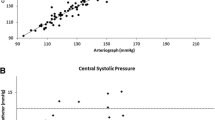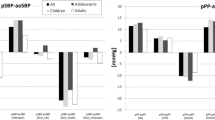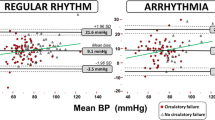Abstract
The blood pressure waveform is modified on distal propagation by phenomena such as dispersion, reflection and the state of the arterial compliance. The consequent effects are amplification and narrowing of the wave, with an increased systolic, reduced diastolic and essentially unaltered mean blood pressure. The Finapres measures the peripheral pressure using the volume clamp principle; it has not been validated under altered physiological conditions and during pharmacodynamic interventions. We studied simultaneous Finapres and brachial blood pressures (using a conventional oscillometric sphygmomanometer—Vitalmap) in ten normal volunteers at rest, and during dynamic exercise and a cold pressor test. The effects of pharmacodynamic intervention were examined following beta-adrenoceptor blockade with propranolol (160 mg) or beta-adrenoceptor modulation with the beta-adrenoceptor partial agonist celiprolol (400 mg). The Finapres systolic pressure was significantly higher than the brachial value during all three test states. The difference between the systolic pressures measured by the two devices was shown to increase significantly during the cold pressor test, but not during dynamic (supine bicycle) exercise. The Finapres diastolic pressure was significantly higher than the Vitalmap value during exercise and the cold pressor test. The differences between the two methods increased significantly over time. Beta-adrenergic blockade with propranolol or modulation with celiprolol had no significant interaction with the pressure differences between the Finapres and Vitalmap techniques. The results would support the view that the Finapres can provide blood pressure information which is robust under most circumstances. Although this pharmacodynamic intervention did not alter the relationship between the peripheral and central blood pressure, it is important to note that this dynamic relationship is sensitive to circulatory loading conditions and wave transmission characteristics; it is possible that the Finapres could be less reliable in clinical settings where potent vasoactive agents were being administered.
Similar content being viewed by others
References
Molhoek GP, Wesseling KH, Setteis JJM, van Vollenhoven E, Weeda HWH, deWit B. Evaluation of the Penaz servo plethysmomanometer for the continuous non invasive measurement of finger blood pressure.Basic Res Cardiol 1984;79: 598–609.
Penaz J, Voight A, Teichmann W. Beitrag sur fortlaufenden indirekten Blutdruckmessung.Zschr Inn Med 1976;31: 1030–1033.
Parati G, Casadei R, Groppelli A, di Rienzo M, Mancia G. Comparison of finger and intra-arterial blood pressure monitoring at rest and during laboratory testing.Hypertension 1989;13: 647–655.
Imholz BPM, van Montfrans GA, Settels JJ, van der Hoeven GMA, Karemaker JM, Weiling W. Continuous non invasive blood pressure monitoring: reliability of Finapres device during the Valsalva manoeuvre.Cardiovasc Res 1988;22: 390–397.
Smith JJ, Kampie JP. Pressure and flow in the arterial and venous system. In: Smith JJ, Kampie JP, eds.Circulatory Physiology. 3rd edn. Baltimore: Williams and Wilkens, 1990; 89–109.
Silke B, Spiers JP, Boyd S, Graham E, McParland G. Evaluation of non-invasive blood pressure measurement by the Finapres method at rest and during dynamic exercise in subjects with cardiovascular insufficiency.Clin Auton Res 1994;4: 49–56.
Doshen HD, Rosenthal RR, Brown R. Celiprolol, atenolol and propranolol: a comparison of pulmonary effects in asthmatic patients.J Cardiovasc Pharmacol 1986;8: S105.
Mancia G. The central and peripheral haemodynamics of celiprolol.Am Heart J 1988;116: 1405.
Rodriguez-Rodrigo FJ, Ruiz I, Lorenzo D, Alag I, Terol I, Cuenca P. Short term effects of celiprolol on blood pressure and left ventricular performance in hypertensive cardiomyopathy.J Cardiovasc Pharmacol 1992;20: 683–687.
Mancia G, Grassi G, Parati G. Effects of celiprolol in reflex control of the cardiovascular system in essential hypertension.J Cardiovasc Pharmacol 1986;8: S67-S74.
Rueckert DA, Slane PR, Hanson P. Adding beta agonism does not improve β1 blockade exercise responses in hypertensives.Med Sci Sports Exerc 1994;26: 945–950.
Hardman JG, Limbird LE, eds.Goodman and Gilman's The Pharmacological Basis of Therapeutics, 9th edn. London: McGraw-Hill, 1995.
Wheeldon NM, McDevitt DG, Lipworth BJ. Selectivity of antagonist and partial agonist activity of celiprolol in normal subjects.Br J Pharmacol 1992;34: 337–343.
De Cree J, Cobo C, Geinkens H, Verhaegen H. Comparison of the subacute haemodynamic effects of atenolol, propranolol, pindolol and nebivolol.Angiology 1990;41: 95–105.
McDonald DA.Blood Flow in Arteries. London: Arnold, 1960.
Caro CG, Pedly TJ, Schroter RC, Seed WA.The Mechanics of Circulation. Oxford: Oxford University Press, 1978.
Wetterer E. Flow and pressure in the arterial system, their haemodynamic relationship and the principals of their measurement.Minn Med 1954;37: 77–86.
Berne RM.Cardiovascular Physiology, 7th edn. London: Mosby, 1995.
Bos WJ, Imholz BP, van Goudoever J, Wesseling KH, van Montfrans GA. The reliability of non-invasive continuous finger blood pressure measurement in patients with both hypertension and vascular disease.Am J Hypertens 1992;5: 529–535.
Dorlas JC, Nijboer JA, Butijn WT, van der Hoever GMA, Settels JJ, Wesseling KH. Effects of peripheral vasoconstriction on the blood pressure in the finger, measured continuously by a new non-invasive method (the Finapres).Anesthesiology 1985;62: 342–345.
Stratmann HG, Kennedy HL. Evaluation of coronary artery disease in the patient unable to exercise.Am Heart J 1989;117: 1344–1365.
Wasserman AG, Reiss L, Katz RJ, et al. Insensitivity of the cold pressor stimulation test for the diagnosis of coronary artery disease.Circulation 1983;67: 1189–1193.
Northcote RJ, Cooke MJD. How useful are the cold pressor test and sustained isometric hand grip exercise with radionuclide ventriculography in the evaluation of patients with coronary artery disease?Br Heart J 1987;57: 319–328.
Calhoun DA, Mutinga MC, Collins AS, Wyss JM, Oparil S. Normotensive blacks have heightened sympathetic response to cold pressor tests.Hypertension 1993;22: 801–805.
McLean JK, Sathasivam P, MacNaughton K, Graham TB. Cardiovascular and norepinephrine responses of men and women to two cold pressor tests.Can J Physiol Pharmacol 1992;70: 36–42.
Mudge GH, Grossman W, Mills RM, Lesch M, Braunwald E. Reflex increase in coronary vascular resistance in patients with ischaemic heart disease.N Engl J Med 1976;295: 1333.
Abboud FM, Eckstein JW. Reflex vasoconstrictor and vasodilator responses in man.Circ Res 1966;18: 1–96.
Levick JR.An Introduction to Cardiovascular Pharmacology, 2nd edn. Oxford: Butterworth-Heinemann, 1995.
O'Rourke MF, Taylor MG. Vascular impedance of the femoral bed.Circ Res 1966;18: 126–139.
Price HL, Cooper LH, Warden JC. Control of the splanchic circulation in man.Circ Res 1967;21: 33.
Bauer K, Dietersdorfer F, Kulk G. Assessment of beta adrenergic receptor blockade after isamoltane, a 5 HT1 receptor active compound, in healthy volunteers.Clin Pharmacol Ther 1993;53: 675–683.
Frishman WH, Heiman MJ, Soberman J, Greenburg S, Eff J. Comparison of celiprolol and propranolol in stable angina pectoris.Am J Cardiol 1991;67: 665–670.
Rosen RC, Oostis JB, Seltzer LG, Taska LS, Holzer BC. Beta blocker effects on heart rate during sleep.Sleep 1991;14: 43–47.
Taylor SA, Beattie A, Silke B. Celiprolol in the treatment of hypertension.J Cardiovasc Pharmacol 1986;8: S127-S131.
Author information
Authors and Affiliations
Rights and permissions
About this article
Cite this article
McAuley, D., Silke, B. & Farrell, S. Reliability of blood pressure determination with the Finapres with altered physiological states or pharmacodynamic conditions. Clinical Autonomic Research 7, 179–184 (1997). https://doi.org/10.1007/BF02267979
Received:
Accepted:
Issue Date:
DOI: https://doi.org/10.1007/BF02267979




